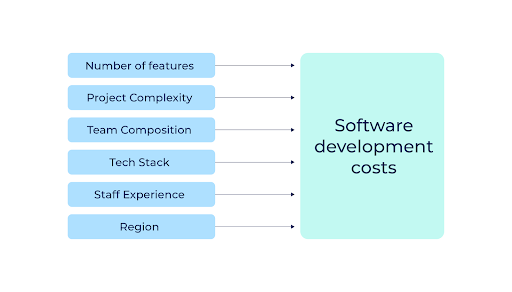Inquiry Form




Software development cost estimates vary widely depending on factors such as project complexity, technology stack, team expertise, and geographical location. While providing an exact average is challenging due to the diversity of projects, we can offer a general overview of the key considerations that influence software development costs.
Simple projects like basic mobile apps or small websites generally cost less. Complex projects involving intricate features, advanced functionalities, or enterprise-level solutions tend to have higher development costs.
The choice of programming languages, frameworks, and tools influences costs. Adopting cutting-edge technologies may increase development costs but can enhance performance and scalability.
The size and expertise of the development team impact costs. Skilled professionals, especially those with expertise in emerging technologies like AI or blockchain, may command higher rates.
The adoption of project management methodologies like Agile or Scrum can affect costs. Efficient project management is an investment that contributes to streamlined development but comes with associated expenses.
Rigorous testing, including manual and automated processes, is crucial for ensuring a high-quality product. Allocating a budget for thorough testing contributes to a robust software development lifecycle.

Implementing robust security features to protect against cyber threats is essential. Security investments may include encryption, regular audits, and compliance with industry standards.
Projects in regulated industries (e.g., healthcare, finance) may incur additional costs to meet compliance requirements. Adhering to industry standards is crucial for legal and operational reasons.
Designing software engineers with scalability and seamless integration capabilities may increase upfront costs. Scalability investments ensure the software can evolve with changing business needs.
The location of the development team influences costs, with offshore teams potentially offering cost advantages. Considerations such as time zone differences and communication challenges should be weighed against potential savings.
Budgeting for post-launch support and maintenance is essential for addressing issues and implementing updates.
Ongoing support ensures the Custom software development
remains aligned with evolving business requirements.


Clearly outline the project's goals, functionality, and desired outcomes. Understand the problem you're solving and the value you aim to deliver.
Investigate similar solutions, identify competitors, and analyze user needs. This informs your strategy and helps in creating a unique selling proposition.
Develop a comprehensive project plan, including timelines, milestones, and resource allocation. Define the project scope to avoid unnecessary feature creep.
Create wireframes and prototypes to visualize the user interface and user experience. Consider feedback loops to refine the design before moving forward.
Write code according to the specifications and design. Utilize version control systems and follow coding best practices. Break down tasks into sprints for iterative development.
Implement various testing methodologies such as unit testing, integration testing, and user acceptance testing. Identify and rectify bugs promptly.
Roll out the software to a production environment. Ensure that deployment is smooth and monitor for any issues. Have a rollback plan in case of unforeseen problems.

Implement monitoring tools to track performance, user behavior, and potential issues. Provide ongoing support, updates, and improvements as needed.
Gather feedback from users and stakeholders. Use this feedback to iterate on the software development agency, making improvements and adding features as necessary.
Document the codebase, APIs, and user manuals comprehensively. This aids in future maintenance, onboarding new developers, and understanding system functionalities.
Implement security best practices throughout the development process. Regularly update dependencies and conduct security audits to identify and address vulnerabilities.
Evaluate performance under load and plan for scalability. Optimize code and databases for efficiency. Continuously monitor and refine to ensure the software can handle growth.
Conduct a thorough review of the entire project. Analyze what worked well, and what could be improved, and document lessons learned for future projects.

In 2024, the cost of software development is a multifaceted consideration, encompassing various factors that collectively shape the investment landscape. As a software development company embarks on projects, a holistic approach that balances innovation with practicality is key. Collaborating with experienced development teams, leveraging the right technologies, and anticipating long-term needs contribute to a successful software development process. Ultimately, understanding the nuances of cost factors in 2024 empowers decision-makers to navigate the evolving technology landscape with confidence and foresight Company Globalrns.